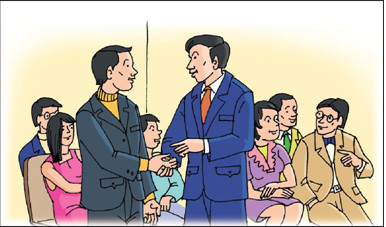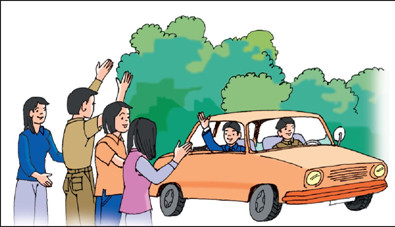Đừng bỏ lỡ những tính năng hấp dẫn của Baitap365.com
Unit 3: Ways Of Socialising - Các cách thức giao tiếp xã hội
Reading - Unit 3 trang 30 Tiếng Anh 12
Speaking - Unit 3 trang 32 Tiếng Anh 12 Listening - Unit 3 trang 34 Tiếng Anh 12 Writing - Unit 3 trang 36 Tiếng Anh 12 Language focus - Unit 3 trang 38 Tiếng Anh 12 Test Yourself A - Unit 3 trang 41 Tiếng Anh 12 Ngữ pháp: Câu tường thuật (Reported speech) - Unit 3 - Tiếng Anh 12 Ngữ âm: Trọng âm của từ có hai âm tiết - Unit 3 - Tiếng Anh 12 Vocabulary - Phần từ vựng - Unit 3 Tiếng Anh 12Reading - Unit 3 trang 30 Tiếng Anh 12
In the upper picture, the two men are shaking hands and saying the greetings to each other.
Before
I. BEFORE YOU READ


1. What are the people in the pictures doing?
(Những người trong các bức tranh đang làm gì?)
2. What will you do and/or say if
(Bạn sẽ làm gì và / hoặc nói nếu)
- you want to get your teacher's attention in class?
(bạn muốn thu hút sự chú ý của giáo viên trong lớp)
- you need to ask someone a question, but they are busy talking to someone else?
(bạn cần hỏi ai đó một câu hỏi, nhưng họ đang bận nói chuyện với ai đó?)
While - Bài đọc
II. WHILE YOU READ
Read the passage and do the tasks that follow.
(Đọc đoạn văn và làm bài tập kèm theo.)
To attract someone’s attention so that we might speak to that person, we can use either verbal or non-verbal forms of communication. Let us look at non-verbal communication in English. Probably the most common way of attracting someone’s attention is by waving. For example, if we are at a noisy party and see a friend come in the door about 20 metres away, we might raise our hand and wave to her as a signal that we see her.
But how hard can we wave in a situation like this? Suppose you are at the airport, and you see your brother get off the plane and begin walking toward you. If you are excited, you might jump up and down and wave as hard as you can to attract his attention. This is the instance where big, obvious non-verbal signals are appropriate.
There are, however, some social situations where smaller non-verbal signals are more appropriate. In a restaurant, for example, if we want to attract the attention of our waiter, we have several choices. We can wait until he passes near us, catch his eye, and nod slightly to let him know we would like him to come to our table. Or we can raise our hand slightly to show that we need assistance. We do not whistle or clap our hands to get the person’s attention. That is considered impolite and even rude.
In most social situations where some informality is allowed, a brief raise of the hand and a small wave is fine. For instance, if you are walking across the schoolyard and see your teacher approaching you, a small friendly wave to attract his or her attention is appropriate.
Once you’ve got your friend’s attention, you shouldn’t point at the person or thing you want her to look at. A slight nod will do. Pointing at someone is usually considered rude. Of course, there are times when pointing is perfectly acceptable, such as when a teacher wants to get someone’s attention in class. The teacher often points to the student and says, “David, would you read the next sentence, please?” Pointing here is not impolite; it’s simply a way to get someone’s attention.
While - Task 1
Task 1: Give the Vietnamese equivalent to the following words and phrases.
(Cho từ tương đương tiếng Việt của những từ và cụm từ sau.)
verbal: ___________
rude: ___________
non-verbal: ___________
informality: ___________
approach: ___________
attract some's attention: ___________
attention getter: ___________
a light nod will do: ___________
While - Task 2
Task 2: Decide which of the three options below is the best title for the passage.
(Quyết định sự chọn lựa nào trong ba chọn lựa dưới đây là lựa thích hợp nhất cho đoạn văn.)
A. Attracting Attention: Non-verbal Cues
(Thu hút sự chú ý: những ám hiệu không lời)
B. Attracting Attention by Waving
(Thu hút sự chú ý bằng cách vẫy)
C. The Best Ways of Attracting Attention
(Cách tốt nhất để thu hút sự chú ý)
While - Task 3
Task 3: Answer the following questions.
(Trả lời các câu hỏi sau.)
1. What can we do when we want to attract someone’s attention?
(Chúng ta có thể làm gì khi muốn thu hút sự chú ý của ai đó?)
2. What are considered to be big, obvious non-verbal signals?
(Những gì được coi là tín hiệu phi ngôn rõ ràng và lớn?)
3. What can we do if we want to attract the waiter’s attention?
(Chúng ta có thể làm gì nếu muốn thu hút sự chú ý của người bồi bàn?)
4. If you are walking across the schoolyard and see your teacher approaching you, what can you do to attract his or her attention?
(Nếu bạn đang đi bộ qua sân trường và thấy thầy giáo đang tiếp cận bạn, bạn có thể làm gì để thu hút sự chú ý của mình?)
5. Why shouldn't you point at the person or thins you want your friend to look at once you’ve got his or her attention?
(Tại sao bạn không nên chỉ vào người hoặc thins bạn muốn bạn của bạn để xem xét một khi bạn đã có sự chú ý của mình?)
After
III. AFTER YOU READ
Work in pairs. Discuss the meanings of whistling and hand-clapping in Vietnamese culture.
(Làm việc từng đôi. Thảo luận ý nghĩa của huýt sáo và vỗ tay theo văn hóa Việt Nam.)
Mẹo tìm đáp án nhanh
Search Google: "từ khóa + baitap365" Ví dụ: "Bài 5 trang 13 SGK Vật lí 12 baitap365